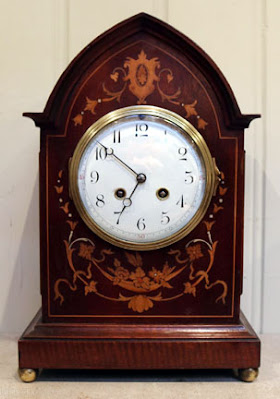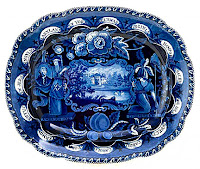 QUESTION: I’ve been interested in clocks for a long time but only recently have I had enough extra cash to start a serious collection. How do I know what clocks to collect? I have a limited budget.
QUESTION: I’ve been interested in clocks for a long time but only recently have I had enough extra cash to start a serious collection. How do I know what clocks to collect? I have a limited budget.
ANSWER: One of the quirky things about collecting clocks is that, depending on the size, they can not only take up space but also time–the time needed to keep them running. Clocks are precision instruments, even the smallest alarm clock has tiny working parts that need regular maintenance.
However, not every old clock is worth collecting. In fact, collecting clocks can be a challenge because of the amount of space they take up. So people who do collect them are very particular.
 With antique clocks, condition is prime. To be worth anything, an antique clock needs to be in working order—in other words, it needs to tell time almost as good as it did when first made.
With antique clocks, condition is prime. To be worth anything, an antique clock needs to be in working order—in other words, it needs to tell time almost as good as it did when first made.
From 1680 to 1840, tall case clocks was popular in America. Master clockmakers produced fewer than two dozen of these clocks a year. Eventually, these clocks became known as grandfather clocks.
While these early clocks demonstrated the finest quality of workmanship, the cost of $50 or more excluded anyone but the very rich from owning one. Today, these same clocks can sell for four or five figures. While clockmakers produced the clockworks, coffin makers made the cases. Until about 1770, the brass dials had silver decoration. Painted dials and those coated with white enamel didn’t appear until 1790. Cheaper models had plain paper dials pasted on an iron or wooden background. While clockmakers produced the clockworks, coffin makers made the cases. Until about 1770, the brass dials had silver decoration.
 Next in the timeline of clockmaking came wall clocks. In 1802, Simon Willard patented his improved Timepiece," a wall clock shaped like a banjo. This style would be copied many times. Years later, the Waterbury Clock Co. manufactured a .umber of banjo clocks and used the name "Willard."
Next in the timeline of clockmaking came wall clocks. In 1802, Simon Willard patented his improved Timepiece," a wall clock shaped like a banjo. This style would be copied many times. Years later, the Waterbury Clock Co. manufactured a .umber of banjo clocks and used the name "Willard."
While the Willards introduced new lock styles, it was Gideon Roberts, a Revolutionary War veteran from Bristol, Connecticut., who began to make the clock more affordable. Roberts replaced he brass movements used to that point with less expensive wooden movements and also used painted paper dials. Imitating the German styling known as wag-on-the-wall, Roberts would also make clocks without a case. The exposed works could be encased for an additional fee. Using these methods, Roberts was able to produce 10 or more clocks at a time.
 Clock manufacturers produced an infinite number of styles of mantel clocks from 1810 to 1860. These included papier-maché clocks, as well as pillar-and-scroll clocks with wooden movements.
Clock manufacturers produced an infinite number of styles of mantel clocks from 1810 to 1860. These included papier-maché clocks, as well as pillar-and-scroll clocks with wooden movements.
 Eli Terry been has generally credited with bringing mass-production to clockmaking in America. In 1797, Terry was granted the first American clock-related patent. In 1807, he signed a contract to make 4,000 clock movements within three years. Legend has it that Terry spent the first two years designing and constructing the machinery, which would allow him to fulfill his obligation. In 1810, with the help of apprentices Seth Thomas and Silas Hoadley, Terry's pillar-and-scroll shelf clock became the first inexpensive, factory-produced clock available to the American public. Thomas and Hoadley purchased Terry's factory that same year and worked together until 1813. Thomas eventually became one of America's best-known clockmakers.
Eli Terry been has generally credited with bringing mass-production to clockmaking in America. In 1797, Terry was granted the first American clock-related patent. In 1807, he signed a contract to make 4,000 clock movements within three years. Legend has it that Terry spent the first two years designing and constructing the machinery, which would allow him to fulfill his obligation. In 1810, with the help of apprentices Seth Thomas and Silas Hoadley, Terry's pillar-and-scroll shelf clock became the first inexpensive, factory-produced clock available to the American public. Thomas and Hoadley purchased Terry's factory that same year and worked together until 1813. Thomas eventually became one of America's best-known clockmakers.
 The cuckoo clock dates back to 1730 when Swiss and Bavarian clockmakers developed the pendulum striking mechanism and the cuckoo concept. Unfortunately, cuckoo clocks never became popular with American manufacturers, but many American travelers purchased them in Germany and Switzerland, as did soldiers returning from World War I and II..
The cuckoo clock dates back to 1730 when Swiss and Bavarian clockmakers developed the pendulum striking mechanism and the cuckoo concept. Unfortunately, cuckoo clocks never became popular with American manufacturers, but many American travelers purchased them in Germany and Switzerland, as did soldiers returning from World War I and II..
By 1850, technology would change most movements from weight to spring-driven, and brass coiled springs would be replaced by cheaper steel springs. Among the most popular clocks were the schoolhouse clock, the pressed oak "gingerbread" kitchen clock, the steeple clock, and the OG clock, which featured a double continuous S-shaped molding.
 Novelty clocks have become another popular collectible category. There have been flower clocks, animated animal clocks, advertising clocks, and even dancing girl clocks.
Novelty clocks have become another popular collectible category. There have been flower clocks, animated animal clocks, advertising clocks, and even dancing girl clocks.
Researching an antique clock’s origins can be challenging. Those made in the 18th and at least the first half of the 19th century bore no labels. Some clockmakers did sign their works, especially those that made tall case clocks. Generally, they signed them somewhere on the dial. Many of those that did have labels in the latter part of the 1800s, lost them over time.
 The key to acquiring museum quality clocks is learning how to research, properly identify, and evaluate antique clocks. Rarity, provenance, originality, quality of manufacture, and quality of restoration all affect value.
The key to acquiring museum quality clocks is learning how to research, properly identify, and evaluate antique clocks. Rarity, provenance, originality, quality of manufacture, and quality of restoration all affect value.
An antique clock isn’t always as good as it appears. While a clock may look great from the outside, the condition of its works is what counts. Over time, abuse and bad repairs can add up, rendering what could have been a great find nearly worthless.
The sad thing is that many antique clocks cannot be repaired. Even the best horologist can’t work miracles on many old clockworks. The reason is that most cannot obtain the parts needed to do the repairs. And the few younger clockmakers just don’t have the skills necessary to make the parts themselves.
 Because of the wide range of antique clocks available, many collectors choose to specialize, collecting one type of clock from different makers or a variety of clocks from the same maker, perhaps Seth Thomas. Another possibility is to collect a fine example of each type of clock. Some collectors assemble collections of clocks with different types of movements.
Because of the wide range of antique clocks available, many collectors choose to specialize, collecting one type of clock from different makers or a variety of clocks from the same maker, perhaps Seth Thomas. Another possibility is to collect a fine example of each type of clock. Some collectors assemble collections of clocks with different types of movements.
But unlike a piece of antique furniture that has been restored, an antique clock that isn’t running isn’t worth collecting.
To read more articles on antiques, please visit the Antiques Articles section of my Web site. And to stay up to the minute on antiques and collectibles, please join the over 30,000 readers by following my free online magazine, #TheAntiquesAlmanac. Learn more about "The Age of Photography" in the 2023 Fall Edition, online now. And to read daily posts about unique objects from the past and their histories, like the #Antiques and More Collection on Facebook.


































